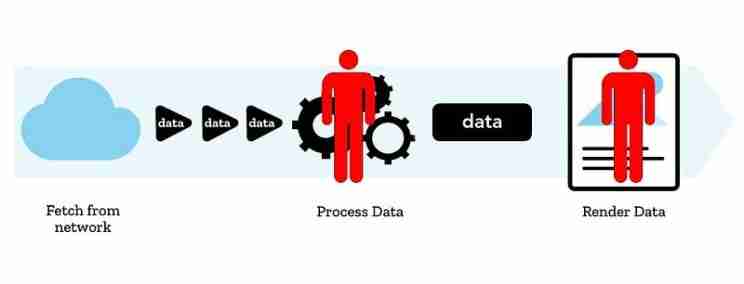Streams API が Web 開発者にとって大きな変革となる理由
2024 年 11 月 8 日に公開
まず、Web 上でデータがどのように送信されるかを説明しましょう。単一の連続ストリームとして送信されるわけではありません。代わりに、より小さなチャンクに分割されます。受信側では、すべてのデータを受信した後、コンシューマまたはアプリケーションがこれらのチャンクを正しい順序と形式で再組み立てする必要があります。このプロセスは、画像、ビデオ、その他の比較的大きなデータ型に対して自動的に行われます。

つまり、Streams API が提供するのは、完全なデータが利用可能になるのを待つ代わりに、
- データは消費者段階でチャンクとして受信されるため、リアルタイムで処理されます。これは非常に便利で、この記事で示す例のような大量のデータを扱う場合には非常に不可欠です。
- また、データをストリームとして扱うこともできます。これは、特定のタイプのチャンクを送信する場合にバックエンド側で便利であり、同様のワーカーを使用してネットワーク経由で大きなファイルを送信する場合にフロントエンドで役立ちます。」
- リアルタイム データ処理: チャンクで受信したデータをリアルタイムで処理できます。この機能は、この記事で説明する例のように、大量のデータを処理する場合に非常に重要です。
(この記事は前半部分に焦点を当てています)
- ストリームベースのデータ管理: Streams API を使用すると、データを連続ストリームとして扱うことができます。これは、バックエンドで特定のチャンクでデータを送信する場合や、フロントエンドで Web ワーカーを使用して大きなファイルを効率的にアップロードする場合に役立ちます。
まず、Fetch API を使用してデータを受信する従来の方法と、新しい Streams API アプローチを比較してみましょう。フェッチ API を使用した従来のアプローチ
fetch("url") .then((応答) => { // 最終データを受け取る前に中間ステップがあることに注意してください // 実際に何を受け取るか見てみましょう console.log(response.body);応答.text()を返します; }) .then((data) => { // データを使用して演算を実行します });
fetch("url") .then((response) => {
// Note that there is a middle step before we receive the final data
// Let's see what we actually receive
console.log(response.body); return response.text(); }) .then((data) => { // Perform operations with the data
});
この例では、response.body は ReadableStream オブジェクトです:
fetch("url") .then((response) => {
// Note that there is a middle step before we receive the final data
// Let's see what we actually receive
console.log(response.body); return response.text(); }) .then((data) => { // Perform operations with the data
});
ここでは、Streams API の最初のコンポーネントである ReadableStream に遭遇します。 ReadableStream コンストラクターは、読み取り可能なストリーム オブジェクトを作成して返します。これにより、ストリーミング データをより効率的に処理できるようになります。このコンストラクターを使用すると、データセット全体が利用可能になるのを待つのではなく、データをチャンク単位で管理できます。
fetch("url") .then((response) => {
// Note that there is a middle step before we receive the final data
// Let's see what we actually receive
console.log(response.body); return response.text(); }) .then((data) => { // Perform operations with the data
});
リアルタイムで送信されるデータにアクセスするには、オブジェクトを処理する関数を実装する必要があります。この関数は次のようにする必要があります:
1 ReadableStream をプロミスとして受信します。
- データのすべてのチャンクが受信されるまで待ちます。
- チャンクを完全なデータセットにマージします。約束として完全なデータを返します。

ReadableStream の詳細
interface ReadableStreamインターフェイス ReadableStreamDefaultReader{ readonly locked: boolean; cancel(reason?: any): Promise ; getReader(options: { mode: "byob" }): ReadableStreamBYOBReader; getReader(): ReadableStreamDefaultReader ; getReader(options?: ReadableStreamGetReaderOptions): ReadableStreamReader ; pipeThrough ( transform: ReadableWritablePair , options?: StreamPipeOptions ): ReadableStream ; pipeTo( destination: WritableStream , options?: StreamPipeOptions ): Promise ; tee(): [ReadableStream , ReadableStream ]; }
fetch("url") .then((response) => {
// Note that there is a middle step before we receive the final data
// Let's see what we actually receive
console.log(response.body); return response.text(); }) .then((data) => { // Perform operations with the data
});
ストリームを操作するには、ReadableStreamDefaultReader を返す getReader() を使用します。
これは、特定のユーザー向けに PGN 形式 (テキストと考えてください) のゲーム用に Lichess.org の API にリクエストを行う例です。最終結果はテキストで表示される必要があります。fetch("https://lichess.org/api/games/user/gg").then((response) => { console.log(応答); const readablestream = 応答.body; console.log(読み取り可能なストリーム); const リーダー = readablestream.getReader(); コンソール.ログ(リーダー); });
fetch("url") .then((response) => {
// Note that there is a middle step before we receive the final data
// Let's see what we actually receive
console.log(response.body); return response.text(); }) .then((data) => { // Perform operations with the data
});
出力:
fetch("url") .then((response) => {
// Note that there is a middle step before we receive the final data
// Let's see what we actually receive
console.log(response.body); return response.text(); }) .then((data) => { // Perform operations with the data
});
ReadableStream.locked = true の場合、getReader() がエラーをスローするため、同時に複数のリーダーを持つことはできないことに注意してください。そのため、リーダーを変更したい場合は、まず ReadableStreamDefaultReader を使用してロックを解放する必要があります。リリースロック()
fetch("url") .then((response) => {
// Note that there is a middle step before we receive the final data
// Let's see what we actually receive
console.log(response.body); return response.text(); }) .then((data) => { // Perform operations with the data
});
今度は、2 つの変数を持つリーダー内で読み取り関数を使用します
- value: UintArray に現在のチャンクの内容があり、各 int を char に変換してマージするか、単に TextDecoder().decode() を使用することで文字列に変換できます。
fetch("url") .then((response) => {
// Note that there is a middle step before we receive the final data
// Let's see what we actually receive
console.log(response.body); return response.text(); }) .then((data) => { // Perform operations with the data
});
完全なコード例
- ストリームの処理とチャンクの結合の完全な例を次に示します。
interface ReadableStream// console.log(値) Uint8Array(551) [ 91、69、118、101、110、116、32、34、82、97、116、101、 100、32、98、108、105、116、122、32、103、97、109、101、 34、93、10、91、83、105、116、101、32、34、104、116、 116、112、115、58、47、47、108、105、99、104、101、115、 115、46、111、114、103、47、90、122、78、66、90、119、 100、71、34、93、10、91、68、97、116、101、32、34、 50、48、50、48、46、48、49、46、49、48、34、93、 10、91、87、104、105、116、101、32、34、86、101、101、 118、101、101、50、 ... 451 件以上のアイテム ] // console.log(new TextDecoder().decode(value)) [イベント「格付け電撃戦」] [サイト「https://lichess.org/ZzNBZwdG」] [日付「2020.01.10」] [ホワイト「Veevee222」] [ブラック「gg」] [結果「0-1」] [UTC日付「2020.01.10」] [UTC時間「20:21:02」] [ホワイトエロ「1858」] [ブラックエロ「1863」] [WhiteRatingDiff "-6"] [BlackRatingDiff「35」] [バリエーション「スタンダード」] [タイムコントロール「180 0」] [エコ「C00」] [終了「正常」]{ readonly locked: boolean; cancel(reason?: any): Promise ; getReader(options: { mode: "byob" }): ReadableStreamBYOBReader; getReader(): ReadableStreamDefaultReader ; getReader(options?: ReadableStreamGetReaderOptions): ReadableStreamReader ; pipeThrough ( transform: ReadableWritablePair , options?: StreamPipeOptions ): ReadableStream ; pipeTo( destination: WritableStream , options?: StreamPipeOptions ): Promise ; tee(): [ReadableStream , ReadableStream ]; }
interface ReadableStream1. e4 e6 2. d4 d6 3. c4 Nf6 4. Nc3 c5 5. f4 cxd4 6. Qxd4 Nc6 7. Qd1 b6 8. g3 Bb7 9. Bg2 Rc8 10. Nf3 Be7 11. O-O O-O 12. b3 Nb4 13. Bb2 a5 14.Re1 Qc7 15. a3 Na6 16. Rc1 Nc5 17. Qd4 Nxb3 18. Qd1 Nxc1 19. e5 0-1{ readonly locked: boolean; cancel(reason?: any): Promise ; getReader(options: { mode: "byob" }): ReadableStreamBYOBReader; getReader(): ReadableStreamDefaultReader ; getReader(options?: ReadableStreamGetReaderOptions): ReadableStreamReader ; pipeThrough ( transform: ReadableWritablePair , options?: StreamPipeOptions ): ReadableStream ; pipeTo( destination: WritableStream , options?: StreamPipeOptions ): Promise ; tee(): [ReadableStream , ReadableStream ]; }
fetch("url") .then((response) => {
// Note that there is a middle step before we receive the final data
// Let's see what we actually receive
console.log(response.body); return response.text(); }) .then((data) => { // Perform operations with the data
});
たとえばリンク
たとえば、完全なコード go

たとえば、完全なコードはここにあります
リリースステートメント
この記事は次の場所に転載されています: https://dev.to/anasmustafa123/why-the-streams-api-is-a-game-changer-for-web-developers-1030?1 侵害がある場合は、study_golang にご連絡ください。 @163.com 削除
最新のチュートリアル
もっと>
-
 jQueryを使用して「:After」pseudo-elementのCSS属性を効果的に変更するにはどうすればよいですか?jQueryにおける擬似要素の制限を理解する: "after" after "selector in web開発のように、「擬似要素のような」:後の「擬似要素」:後の視覚的拡張を追加することができます。ただし、jQueryを使用してこれらの要素にアクセス...プログラミング 2025-04-24に投稿されました
jQueryを使用して「:After」pseudo-elementのCSS属性を効果的に変更するにはどうすればよいですか?jQueryにおける擬似要素の制限を理解する: "after" after "selector in web開発のように、「擬似要素のような」:後の「擬似要素」:後の視覚的拡張を追加することができます。ただし、jQueryを使用してこれらの要素にアクセス...プログラミング 2025-04-24に投稿されました -
 JavaScriptオブジェクトのキーをアルファベット順に並べ替える方法は?javascriptオブジェクトをキー で並べ替える方法JavaScriptオブジェクトがある場合は、読みやすさまたは処理目的の改善のためにそのプロパティをアルファベット順に再編成することができます。これは、次の手順を利用することで実現できます。 const unordered = { ...プログラミング 2025-04-24に投稿されました
JavaScriptオブジェクトのキーをアルファベット順に並べ替える方法は?javascriptオブジェクトをキー で並べ替える方法JavaScriptオブジェクトがある場合は、読みやすさまたは処理目的の改善のためにそのプロパティをアルファベット順に再編成することができます。これは、次の手順を利用することで実現できます。 const unordered = { ...プログラミング 2025-04-24に投稿されました -
 Spring Security 4.1以降でCORSの問題を解決するためのガイドスプリングセキュリティCORSフィルター:一般的な問題のトラブルシューティング 既存のプロジェクトにスプリング関連エラーを統合する場合、「Access-Control-Origin」のようなヘッダーが応答に設定されていない場合にCORS関連のエラーに遭遇する場合があります。これを解決するに...プログラミング 2025-04-24に投稿されました
Spring Security 4.1以降でCORSの問題を解決するためのガイドスプリングセキュリティCORSフィルター:一般的な問題のトラブルシューティング 既存のプロジェクトにスプリング関連エラーを統合する場合、「Access-Control-Origin」のようなヘッダーが応答に設定されていない場合にCORS関連のエラーに遭遇する場合があります。これを解決するに...プログラミング 2025-04-24に投稿されました -
 Google APIから最新のjQueryライブラリを取得する方法は?Google Apis から最新のjQueryライブラリを取得します。最新バージョンを取得するために、以前は特定のバージョン番号を使用する代替手段がありました。これは、次の構文を使用するものでした。 /latest/jquery.js .jquery.com/jQuery-latest...プログラミング 2025-04-24に投稿されました
Google APIから最新のjQueryライブラリを取得する方法は?Google Apis から最新のjQueryライブラリを取得します。最新バージョンを取得するために、以前は特定のバージョン番号を使用する代替手段がありました。これは、次の構文を使用するものでした。 /latest/jquery.js .jquery.com/jQuery-latest...プログラミング 2025-04-24に投稿されました -
 C ++の関数またはコンストラクターパラメーターとして排他的なポインターを渡す方法は?コンストラクターと機能のパラメーターとしてユニークなポインターを管理する ユニークなポインター( unique_ptr この方法は、関数/オブジェクトへの一意のポインターの所有権を転送します。ポインターの内容は関数に移動し、操作後に元のポインターが空になります。 :next(std ::...プログラミング 2025-04-24に投稿されました
C ++の関数またはコンストラクターパラメーターとして排他的なポインターを渡す方法は?コンストラクターと機能のパラメーターとしてユニークなポインターを管理する ユニークなポインター( unique_ptr この方法は、関数/オブジェクトへの一意のポインターの所有権を転送します。ポインターの内容は関数に移動し、操作後に元のポインターが空になります。 :next(std ::...プログラミング 2025-04-24に投稿されました -
 純粋なCSSでは、複数の粘着性要素を互いに積み重ねることができますか?純粋なCSSで複数の粘着性要素を互いに積み重ねることは可能ですか?ここ: https://webthemez.com/demo/sticky-multi-header-scroll/index.html JavaScriptの実装ではなく、純粋なCSSを使用することのみです。複数の粘...プログラミング 2025-04-24に投稿されました
純粋なCSSでは、複数の粘着性要素を互いに積み重ねることができますか?純粋なCSSで複数の粘着性要素を互いに積み重ねることは可能ですか?ここ: https://webthemez.com/demo/sticky-multi-header-scroll/index.html JavaScriptの実装ではなく、純粋なCSSを使用することのみです。複数の粘...プログラミング 2025-04-24に投稿されました -
 Firefoxバックボタンを使用すると、JavaScriptの実行が停止するのはなぜですか?navigational Historyの問題:JavaScriptは、Firefoxバックボタンを使用した後に実行を停止します ユーザーは、JavaScriptスクリプトが以前の訪問ページを介して回復したときに実行されない問題に遭遇する可能性があります。この問題は、ChromeやInt...プログラミング 2025-04-24に投稿されました
Firefoxバックボタンを使用すると、JavaScriptの実行が停止するのはなぜですか?navigational Historyの問題:JavaScriptは、Firefoxバックボタンを使用した後に実行を停止します ユーザーは、JavaScriptスクリプトが以前の訪問ページを介して回復したときに実行されない問題に遭遇する可能性があります。この問題は、ChromeやInt...プログラミング 2025-04-24に投稿されました -
 ChatBotコマンドの実行のためにリアルタイムでstdoutをキャプチャしてストリーミングする方法は?コマンド実行からリアルタイムでstdoutをキャプチャする 再起動のライン(コマンド): print(line) このコードでは、subprocess.popen()関数を使用して指定されたコマンドを実行します。 stdoutパラメーターは、subprocess....プログラミング 2025-04-24に投稿されました
ChatBotコマンドの実行のためにリアルタイムでstdoutをキャプチャしてストリーミングする方法は?コマンド実行からリアルタイムでstdoutをキャプチャする 再起動のライン(コマンド): print(line) このコードでは、subprocess.popen()関数を使用して指定されたコマンドを実行します。 stdoutパラメーターは、subprocess....プログラミング 2025-04-24に投稿されました -
 C#でインデントのために文字列文字を効率的に繰り返す方法は?インデンテーションのために文字列を繰り返す アイテムの深さに基づいて文字列をインデントするとき、文字列を繰り返します。 Constructor 同じ文字を繰り返すだけの場合、文字を受け入れる文字列コンストラクターを使用してそれを繰り返すことができます: string indent = ...プログラミング 2025-04-24に投稿されました
C#でインデントのために文字列文字を効率的に繰り返す方法は?インデンテーションのために文字列を繰り返す アイテムの深さに基づいて文字列をインデントするとき、文字列を繰り返します。 Constructor 同じ文字を繰り返すだけの場合、文字を受け入れる文字列コンストラクターを使用してそれを繰り返すことができます: string indent = ...プログラミング 2025-04-24に投稿されました -
 オブジェクトフィット:IEとEdgeでカバーが失敗します、修正方法は?object-fit:カバーがIEとEDGEで失敗します。 CSSでは、一貫した画像の高さを維持するために、ブラウザ全体でシームレスに動作します。ただし、IEとEdgeでは、独特の問題が発生します。ブラウザをスケーリングすると、画像は高さをズームするのではなく幅でサイズを変更し、外観を歪め...プログラミング 2025-04-24に投稿されました
オブジェクトフィット:IEとEdgeでカバーが失敗します、修正方法は?object-fit:カバーがIEとEDGEで失敗します。 CSSでは、一貫した画像の高さを維持するために、ブラウザ全体でシームレスに動作します。ただし、IEとEdgeでは、独特の問題が発生します。ブラウザをスケーリングすると、画像は高さをズームするのではなく幅でサイズを変更し、外観を歪め...プログラミング 2025-04-24に投稿されました -
 なぜ私のCSSの背景画像が現れるのですか?トラブルシューティング:css背景画像が表示されない チュートリアルの指示にもかかわらず、背景画像が読み込まれない問題に遭遇しました。画像とスタイルのシートは同じディレクトリに存在していますが、背景は空白の白いキャンバスのままです。画像ファイル名を囲む引用: background-ima...プログラミング 2025-04-24に投稿されました
なぜ私のCSSの背景画像が現れるのですか?トラブルシューティング:css背景画像が表示されない チュートリアルの指示にもかかわらず、背景画像が読み込まれない問題に遭遇しました。画像とスタイルのシートは同じディレクトリに存在していますが、背景は空白の白いキャンバスのままです。画像ファイル名を囲む引用: background-ima...プログラミング 2025-04-24に投稿されました -
 JavaScriptで複数の変数を宣言する方法はより保守可能ですか?javascriptの複数の変数を宣言する:2つの方法を調査する javascriptでは、開発者はしばしば複数の変数を宣言する必要性に遭遇します。これの2つの一般的なアプローチは次のとおりです。 var variable2 = "Testing ..."; var...プログラミング 2025-04-24に投稿されました
JavaScriptで複数の変数を宣言する方法はより保守可能ですか?javascriptの複数の変数を宣言する:2つの方法を調査する javascriptでは、開発者はしばしば複数の変数を宣言する必要性に遭遇します。これの2つの一般的なアプローチは次のとおりです。 var variable2 = "Testing ..."; var...プログラミング 2025-04-24に投稿されました -
 McRyptからOpenSSLに暗号化を移行し、OpenSSLを使用してMcRyptで暗号化されたデータを復号化できますか?暗号化ライブラリをMcRyptからOpenSSL にアップグレードして、暗号化ライブラリをMcRyptからOpenSLにアップグレードできますか? OpenSSLでは、McRyptで暗号化されたデータを復号化することは可能ですか? 2つの異なる投稿は矛盾する情報を提供します。もしそうなら...プログラミング 2025-04-24に投稿されました
McRyptからOpenSSLに暗号化を移行し、OpenSSLを使用してMcRyptで暗号化されたデータを復号化できますか?暗号化ライブラリをMcRyptからOpenSSL にアップグレードして、暗号化ライブラリをMcRyptからOpenSLにアップグレードできますか? OpenSSLでは、McRyptで暗号化されたデータを復号化することは可能ですか? 2つの異なる投稿は矛盾する情報を提供します。もしそうなら...プログラミング 2025-04-24に投稿されました -
 PHPを使用してXMLファイルから属性値を効率的に取得するにはどうすればよいですか?XMLファイルから属性値をPHP の取得します。提供されている例のような属性を含むXMLファイルを使用する場合: $xml = simplexml_load_file($file); foreach ($xml->Var[0]->attributes() as $att...プログラミング 2025-04-24に投稿されました
PHPを使用してXMLファイルから属性値を効率的に取得するにはどうすればよいですか?XMLファイルから属性値をPHP の取得します。提供されている例のような属性を含むXMLファイルを使用する場合: $xml = simplexml_load_file($file); foreach ($xml->Var[0]->attributes() as $att...プログラミング 2025-04-24に投稿されました -
 PHPを使用してBlob(画像)をMySQLに適切に挿入する方法は?php mysqlデータベースを持つmysqlデータベースにブロブを挿入すると、mysqlデータベースに画像を保存しようとすると、遭遇するかもしれません問題。このガイドは、画像データを正常に保存するためのソリューションを提供します。 ImageId、image) values( &...プログラミング 2025-04-24に投稿されました
PHPを使用してBlob(画像)をMySQLに適切に挿入する方法は?php mysqlデータベースを持つmysqlデータベースにブロブを挿入すると、mysqlデータベースに画像を保存しようとすると、遭遇するかもしれません問題。このガイドは、画像データを正常に保存するためのソリューションを提供します。 ImageId、image) values( &...プログラミング 2025-04-24に投稿されました
中国語を勉強する
- 1 「歩く」は中国語で何と言いますか? 走路 中国語の発音、走路 中国語学習
- 2 「飛行機に乗る」は中国語で何と言いますか? 坐飞机 中国語の発音、坐飞机 中国語学習
- 3 「電車に乗る」は中国語で何と言いますか? 坐火车 中国語の発音、坐火车 中国語学習
- 4 「バスに乗る」は中国語で何と言いますか? 坐车 中国語の発音、坐车 中国語学習
- 5 中国語でドライブは何と言うでしょう? 开车 中国語の発音、开车 中国語学習
- 6 水泳は中国語で何と言うでしょう? 游泳 中国語の発音、游泳 中国語学習
- 7 中国語で自転車に乗るってなんて言うの? 骑自行车 中国語の発音、骑自行车 中国語学習
- 8 中国語で挨拶はなんて言うの? 你好中国語の発音、你好中国語学習
- 9 中国語でありがとうってなんて言うの? 谢谢中国語の発音、谢谢中国語学習
- 10 How to say goodbye in Chinese? 再见Chinese pronunciation, 再见Chinese learning

























